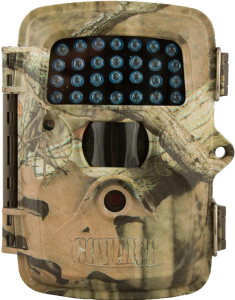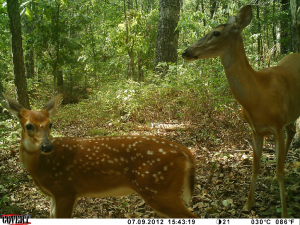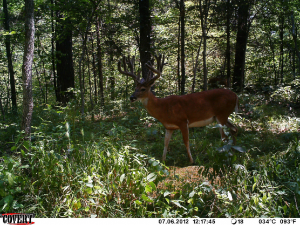
Arguably one of the most innovative wildlife management and hunting tool ever created is the scouting or trail camera.(for example Moultrie panoramic 150 ) Early trail cameras functioned very similar to 35mm cameras; in fact many actually had 35mm cameras housed inside that were triggered by a motion detecting sensor. Users were limited to 24 or 36 exposure film, and would have to exhibit great persistence in monitoring the camera’s exposure count (think about your trail cameras only being able to take a MAXIMUM of 36 pictures), as well as patience while waiting for the film to be developed. The dedication may pay off and the photos may reveal a ghost-like, monarch or just as easily nothing but empty scenery (we have all experienced the “nothing” images). Trail cameras have rapidly evolved, and today’s wildlife manager and hunter have an incredible amount of technology at their fingertips.
The evolution of the trail camera into “digital” format took research and scouting to a whole new level. A user now had the ability to leave a camera in the field for an extended period of time, with little worry that the camera’s photo capacity would fill up. Better yet, the user could view the photos nearly instantaneously on their computer. Today, many hunters will simply “swap cards” or change out the SD memory card in the camera. This way their camera is never “out of service” while reviewing what it captured.
Shortly after digital trail cameras entered the market, a new feature to capture night activity was introduced. Infrared (IR) technology entered as a substitute to the long-time “flash” feature. An IR capable camera, like the 2013 DLC Covert Red 40, would fire a burst of light in the infrared range of the color spectrum. This is far out of a human’s range of vision (we see the IR glow on the camera as it is triggered in low light), and recent research out of The University of Georgia’s Deer Lab suggests it may be of very low visibility to whitetails as well. However, anyone who has seen a deer trigger one of these cameras in a low light situation probably has seen the deer stare down the trail camera. This is more likely because they see the intense change in contrast, rather than the infrared burst that is cast on them. Still, the lack of definitive knowledge that this is the cause has led to the addition of “black flash” trail cameras, like 2013 DLC Covert’s Black 60. Though still utilizing the IR technology in low light, a tinted cover nearly eliminates the red “glow” of the LEDs, at least to the human eye.
The transformation of these tools over the last two decades is truly remarkable. But, we aren’t done yet! In the last 5 years, trail cameras have gone from an incredible tool to capture photos when we can’t be there, to now even recording high-definition video with sound. This capability has dramatically increased the amount of information we can gather on wildlife, particularly with regards to vocalizations and social interactions. We have also introduced cellular capable cameras, like the 2013 DLC Covert Black Ops, that can let you view your photos without having to go to your trail camera.
But with all the technology that deer managers and hunters have available to them with today’s trail cameras, most do not take full advantage of what they are gathering.
Most users download their photos to a computer or tablet, look through them, save some of the best ones, and trash the rest. Of the users who did save some photos, most will collect “cyber dust” somewhere in their hard drive never being viewed again. And maybe right now you are thinking “Well what else you can do with them?”

Every photograph captured by a trail camera is a wealth of knowledge, waiting to be mined by the researcher, manager, or hunter. From factors that may drive deer activity to changes in diet across the seasons, it all can be collected through a trail camera when used correctly. When is the last time you saw a doe and very small, weak, newborn fawn at her side and said “Well that fawn is likely a week or less in age, and it’s (Insert Date). So approximately 200 days ago that doe was bred by a buck. Which means the 5 days prior to that were probably some amazing hunting!” You’re probably thinking about bringing up some summer photos and grabbing a calendar, and start dusting off the math skills. Before you break out your calendar and start back dating, there is now a much simpler way.
The proprietary deer hunting and management software, tRACK RECORD™, developed by The Buck Advisors is one of the most diverse trail camera photo management and maximization tools ever created. Our clients can submit their trail camera photographs “virtually” through their secure My Account webpage with The Buck Advisors. Their advisor will then manage their photographs and create customized reports for things like “Rut Estimation” on your property, or individual buck patterning showing details like estimated core area, travel routes, and the best place, time, and weather conditions to harvest that particular buck.
Nearly everyone who owns a trail camera uses it for scouting, however, and increasingly growing group of trail camera users add them to their deer management toolbox. By far the best way to truly know how your management is positively, negatively, or not affecting your deer herd is through herd monitoring. Without herd monitoring there is NO possible way to determine if you are truly improving your herd, and most important getting a return on the time and money you have put in. Simply just saying, “The deer look bigger, healthier, or there is more of them” is a very subjective measurement. Many hunters collect harvest data, which is a good method of herd monitoring and The Buck Advisors offer Harvest Data Analysis and Management, as well as virtual Jawbone Aging services. Harvest data does come with some bias because the deer that data are collected on were not “randomly” chosen, particularly the bucks. For example, most people managing for quality bucks, try to avoid shooting any young bucks. So if there are no 1 ½, and maybe even no 2 ½ year olds in the harvested deer, does that mean there are not any in the herd? Of course not, it just means that the hunter chose not to harvest any. Now in no way does this mean harvest data is not valuable. Having deer in hand is the most accepted way to age a deer (via Jawbone or Cementum Annuli), and the only way to get weights, which are typically one of the best herd health indicators.
But there is a lot of other information that managers desire, so how do we get around this bias to accurately collect data?

Well this is an article about trail cameras. Using trail cameras, particularly in the form of The Buck Advisors’ Trail Camera Survey service offered, a manager or hunter can gain incredible data like buck to doe ratio, fawn recruitment, age structure, antler quality by age class, and much more in a relatively unbiased manner. The Buck Advisors can either come On-site to set up the camera survey using your trail cameras, or DLC Covert Scouting Cameras provided by The Buck Advisors on a rental basis. If you wish to have more of a DIY path, The Buck Advisors can provide you with instructional material to set up your survey, and you can upload your photos through your My Account at www.thebuckadvisors.com or you can mail the cards to our advisors who will promptly return them once they are downloaded into the system.
So the next time you look at a trail camera or a trail camera photograph, think about the evolution of the technology and amount of information you have the ability to gain.
All clients of The Buck Advisors are eligible for exclusive discounts on DLC Covert Scouting Cameras as well as other wildlife management and hunting products, which have been tried and tested rigorously by our advisors and we have determined them to be some of the highest quality, yet affordable products on the market.
No comments:
Post a Comment